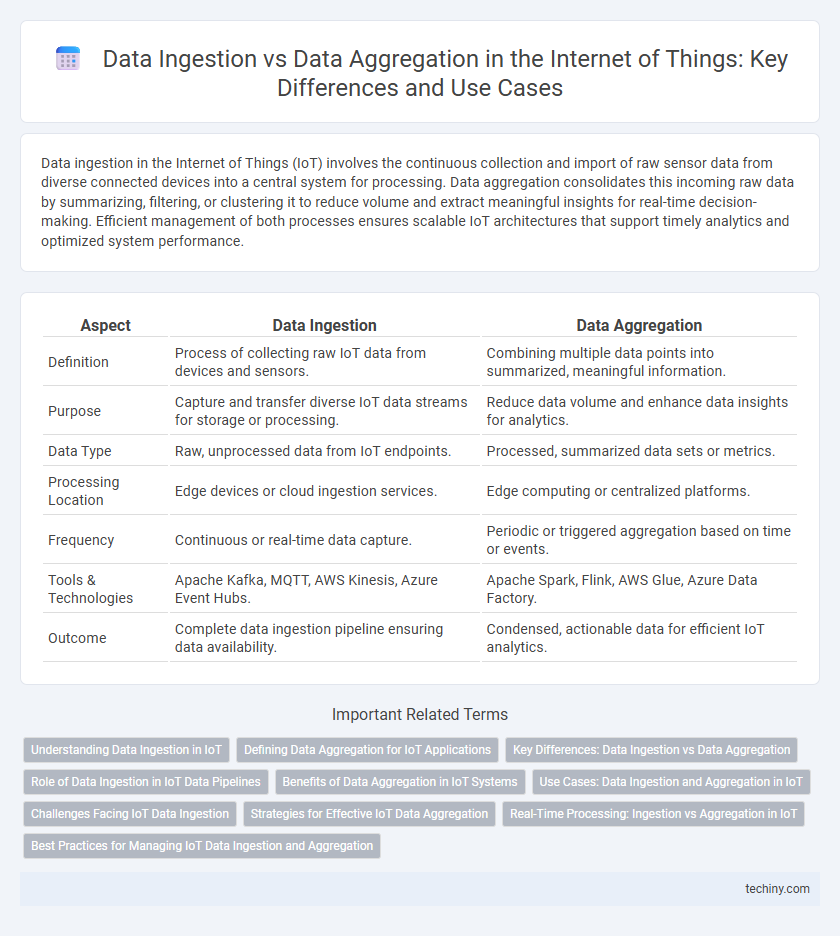Data ingestion in the Internet of Things (IoT) involves the continuous collection and import of raw sensor data from diverse connected devices into a central system for processing. Data aggregation consolidates this incoming raw data by summarizing, filtering, or clustering it to reduce volume and extract meaningful insights for real-time decision-making. Efficient management of both processes ensures scalable IoT architectures that support timely analytics and optimized system performance.
Table of Comparison
| Aspect | Data Ingestion | Data Aggregation |
|---|---|---|
| Definition | Process of collecting raw IoT data from devices and sensors. | Combining multiple data points into summarized, meaningful information. |
| Purpose | Capture and transfer diverse IoT data streams for storage or processing. | Reduce data volume and enhance data insights for analytics. |
| Data Type | Raw, unprocessed data from IoT endpoints. | Processed, summarized data sets or metrics. |
| Processing Location | Edge devices or cloud ingestion services. | Edge computing or centralized platforms. |
| Frequency | Continuous or real-time data capture. | Periodic or triggered aggregation based on time or events. |
| Tools & Technologies | Apache Kafka, MQTT, AWS Kinesis, Azure Event Hubs. | Apache Spark, Flink, AWS Glue, Azure Data Factory. |
| Outcome | Complete data ingestion pipeline ensuring data availability. | Condensed, actionable data for efficient IoT analytics. |
Understanding Data Ingestion in IoT
Data ingestion in IoT refers to the process of collecting raw data from diverse sensors and devices for immediate processing or storage. This step ensures continuous, real-time data flow, enabling analytics and decision-making on time-sensitive information such as environmental conditions or machine status. Unlike data aggregation, which summarizes and compiles data, ingestion handles the initial acquisition and integration of heterogeneous data streams crucial for effective IoT system operation.
Defining Data Aggregation for IoT Applications
Data aggregation in IoT applications involves collecting and summarizing data from multiple sensors or devices to reduce redundancy and enhance meaningful insights. By consolidating raw data at the edge or cloud level, data aggregation optimizes bandwidth usage and supports efficient analytics for real-time decision-making in smart environments. Unlike data ingestion, which focuses on capturing and importing data streams, aggregation emphasizes combining data points to create a unified and actionable dataset.
Key Differences: Data Ingestion vs Data Aggregation
Data ingestion in the Internet of Things involves collecting raw data streams from numerous sensors and devices, ensuring real-time input into storage systems or processing pipelines. Data aggregation, by contrast, focuses on summarizing or consolidating this collected data to reduce volume and highlight meaningful metrics, often through averaging or filtering techniques. Key differences include ingestion handling raw, diverse data input, while aggregation processes this data to deliver actionable insights and improve system efficiency.
Role of Data Ingestion in IoT Data Pipelines
Data ingestion in IoT data pipelines is the critical process of collecting raw sensor data from diverse devices and transmitting it efficiently to storage or processing systems. This stage ensures real-time or near-real-time data availability, enabling timely analytics and decision-making. Unlike data aggregation, which summarizes and consolidates data, data ingestion prioritizes seamless data flow and integrity from numerous heterogeneous IoT sources.
Benefits of Data Aggregation in IoT Systems
Data aggregation in IoT systems enhances efficiency by consolidating data from multiple sensors, reducing network bandwidth usage and storage costs. It enables real-time analytics and faster decision-making through summarized, meaningful insights rather than raw data streams. This approach improves scalability and system performance by minimizing data redundancy and optimizing resource utilization across IoT networks.
Use Cases: Data Ingestion and Aggregation in IoT
Data ingestion in IoT involves collecting real-time data streams from numerous sensors and devices, enabling immediate processing for applications like predictive maintenance and environmental monitoring. Data aggregation compiles and summarizes this raw data to reduce volume while enhancing insights, essential for smart city traffic management and energy consumption analysis. Both techniques optimize data flow, supporting scalable analytics and decision-making across diverse IoT use cases.
Challenges Facing IoT Data Ingestion
IoT data ingestion faces challenges such as high-volume streaming data from heterogeneous devices, requiring scalable and real-time processing frameworks to prevent data loss and latency. In contrast, data aggregation consolidates collected data into meaningful summaries but depends heavily on the quality and completeness of ingested data, making ingestion robustness critical. Ensuring secure, efficient data ingestion pipelines that handle diverse protocols, formats, and intermittent connectivity remains a foremost obstacle in IoT deployments.
Strategies for Effective IoT Data Aggregation
Effective IoT data aggregation strategies prioritize real-time processing and edge computing to reduce latency and bandwidth usage while enhancing data accuracy. Implementing hierarchical data aggregation, where sensor data is pre-processed at gateway devices before transmission, optimizes network efficiency and minimizes storage costs. Leveraging scalable cloud platforms with intelligent filtering mechanisms ensures seamless integration and comprehensive insight generation from diverse IoT sensor networks.
Real-Time Processing: Ingestion vs Aggregation in IoT
Data ingestion in IoT involves capturing and importing real-time sensor data streams into processing systems, enabling immediate analysis and response. Data aggregation focuses on summarizing or combining multiple data points from diverse devices to reduce volume and extract meaningful patterns before further processing. Real-time processing emphasizes ingestion to handle continuous data flow, while aggregation optimizes bandwidth and resource usage by consolidating data before analysis.
Best Practices for Managing IoT Data Ingestion and Aggregation
Effective IoT data management requires optimizing both data ingestion and aggregation processes to handle high-velocity streams from diverse sensors while ensuring data integrity and scalability. Best practices include implementing edge computing to preprocess data, deploying robust data validation mechanisms during ingestion, and applying real-time data filtering to reduce noise before aggregation. Prioritizing scalable cloud storage solutions coupled with metadata tagging enhances efficient retrieval and insightful analytics within IoT ecosystems.
Data ingestion vs Data aggregation Infographic

 techiny.com
techiny.com